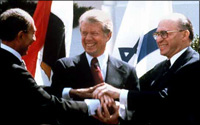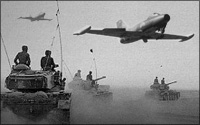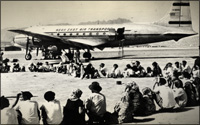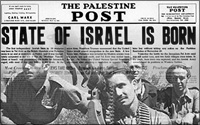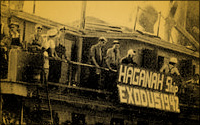 The euphoria that enveloped the Jewish world after the Six Day War was to a great extent short-lived. The deliverance from the threat of total annihilation and the startling, unexpected and overwhelming victory made 1967 to 1969 years of unlimited optimism.
The euphoria that enveloped the Jewish world after the Six Day War was to a great extent short-lived. The deliverance from the threat of total annihilation and the startling, unexpected and overwhelming victory made 1967 to 1969 years of unlimited optimism.
When the war ended Moshe Dayan remarked that he was waiting at the phone for King Hussein to call, because it was obvious that now a deal could be struck. At last, there would be an end to the Arab-Israeli problem.
However, the Arabs proved extremely tenacious in their hatred – even where it was counter-productive. It is an unrelenting, unending, illogical hatred. The Arab states had a post-war conference, the Khartoum Resolution of September 1, 1967, in which they decided what become known as the “Three No’s”:
- No recognition of Israel
- No peace with Israel
- No negotiations with Israel.
Through this policy the Arabs perpetuated the struggle in such a way that no peaceful settlement could arise. There was no room for negotiation. In effect, Israel was locked into its victory.
And Israel did not know what to do with its victory. In retrospect, the Six Day War has to be seen as a lost opportunity – diplomatically, socially, economically and religiously. None of the dreams came to fruition. That gave it a bittersweet quality.
Settling In
Israel began to settle the Golan Heights immediately. Syria was its most implacable enemy and the Golan Heights represented the greatest threat. Over all the years the Syrians had constantly shelled Israeli settlements of there. Therefore, Israel was determined that the Golan Heights would never go back to Syria. In order to make certain of that, Israel began to put settlements there. It was turned into a Jewish area. Many, many settlements were built in the ensuing five years after the Six Day War.
The city of Jerusalem was reunited. The Arab population was given full rights as citizens, participating in all the municipal services, elections, etc. All of the areas around the Old City were now built up with Jewish settlements. Even the Jewish Quarter of the Old City was refurbished. Original owners came with their deeds to prove that they owned the apartments and buildings.
There had been 42 synagogues under Jordanian rule; all had been destroyed by the Jordanians. Many of them now underwent renovations. The plaza was created in front of the Western Wall to provide physical access for tens of thousands of Jews to worship there on a regular basis. Jerusalem became a tremendous bustle of activity.
But Israel did not, for instance, settle the West Bank immediately after the Six Day War. Government policy was not to go beyond the Green Line, as it was called. The reason is because the government hoped against hoped that it would one day “receive the phone call” from the Arabs seeking peace. In anticipation of that call they didn’t want the matter complicated by having Jewish settlements.
War of Attrition
Although the Jews hoped for peace, Nasser’s policy of the “Three No’s” insured a perpetual state of war. As King David had said long before, “I am for peace, but they speak of war.”
Nasser decided that he would remind Israel that a state of war existed, and began what would be called the War of Attrition. Most of this war took place across the Suez Canal. Daily, the Egyptians bombarded the Israeli positions on the east side of the canal. Israel responded, usually via air attacks on the west side of the canal. Once, the Israelis went so far as to send a commando team across to the canal the steal an advanced radar station that the Russians had set up for the Egyptians.
Nasser’s goal was to wear the Israelis down. In the end, Nasser admitted that over 10,000 Egyptians had been killed, as much as they lost in the Six Day War. Nevertheless, it made no difference to him because the 10,000 were expendable.
On the Israeli side, however, the cost of a few hundred lives was seen as too high.
Unwilling to accept the ongoing casualties of the War of Attrition, Israel stepped up its air raids – so much so that Egypt’s Russian advisors became victims on a regular basis. This made the situation even more dangerous.
To avoid the complications, the United States attempted to mediate the situation. Their efforts proved successful. This effectively ended the War of Attrition, but it did not solve anything.
A Conspiracy of Events
In September 1970 Nasser died. While his death brought a sigh of relief to the Jewish world it also opened the door for a new leader ready to start a new war. That leader would be a man few had ever heard of, lieutenant named Anwar Sadat.
He came into office with an agenda. He was going to break the stalemate and get back the Sinai by any means. The first thing he did was include the Soviet Union in his plans. There were as many as an astounding 25,000 Russian advisors at one time engaged in this task. The Russians had their own city outside of Cairo. They would prepare the Egyptian army more than ever before.
The Israeli army, on the other hand, was suffering from a severe case of hubris. The Prime Minister at this time was Golda Meir. David Ben-Gurion once said that she was “the only man in my Cabinet….” Nevertheless, she too was human and underestimated the situation.
Combined with this, the world was becoming more and more dependent upon oil from the Middle East. Since oil was so cheap, and basically controlled by British and American companies, everyone felt secure and no one thought twice about rationing. Automobiles were gas guzzlers. Heat was used inefficiently. There was no talk about conservation of energy. The situation was ripe for disaster.
History is a combination of events; it is never one event. Here it was a combination of Nasser’s death, the rise of Arafat and the PLO, Israeli arrogance, the energy situation in the world, etc. All of these things conspired to come to a head at one time. To the believing Jew it is called hashgachah, God’s hand in history. God orchestrates economic, social, military, diplomatic and other circumstances to form cataclysmic events to shape history.
That is what happened in the Yom Kipper War.
Totally Unprepared
Already a year earlier, Sadat had made up his mind to go to war. In his memoirs he wrote that he was fully prepared to lose the war, but he knew that it would shake up the West and force some sort of change in a situation he found untenable. Fortunately for Israel, though he was prepared to lose the war he was not prepared to win it.
This time Egypt’s objectives were limited: the successful crossing of the Suez Canal and grabbing the Sinai Peninsula. Russian planning prepared them to go a third of the way into Sinai, dig in and wait for the inevitable counterattack. This also is hashgachah, because in the Yom Kipper War Israel was saved by inability of the Arabs to pursue the advantage that they had taken.
A month before the war the Israelis had mobilized their entire army, but it turned out to be a false alarm based on faulty intelligence. This only further paralyzed them to reports of any impending Arab attack. When the High Holy Day season of 1973 rolled around they were not prepared to mobilize them again. As a result, the Bar Lev Line, in addition to being undermanned for the holiday season was manned by a high concentration of cooks and reservists.
War on the Holiest Day of the Year
When the war began, it was one of those events that years later people remembered where they were when they first heard the news. The news was sketchy at first, but it was obvious that the Egyptians had crossed the Suez and the Syrians were attacking in force and penetrating the Israeli defenses in the north.
Jews the world over were shaken. How could it be?
On the Golan there were seven Israeli tanks, whereas the Syrians attacked with more than 450 tanks! They penetrated all the way to Tiberius in the first day! There was nothing between their army and Haifa. Yet, they stopped because they were convinced it was a trap.
The Egyptians, meanwhile, had crossed the Suez and breached the Bar Lev Line in strength. They had even solved the problem of the Israeli air force thanks to Russian technology: new, advanced SAM anti-aircraft missiles. Over 125 Israeli planes would be lost on both fronts. The Arabs also employed advanced hand-held rockets for their foot soldiers to counter Israeli tanks.
The beginning of the war was completely disastrous for Israel. On the second day they tried to counterattack in the Sinai, but their tanks were decimated.
Nevertheless, unbelievably the Israelis gradually turned the tide of battle. First, they did so against Syria. The Israelis not only pushed them off of their gains but further back than when they had begun – to within 14 miles of Damascus.
Then the Israelis stabilized the line in the Sinai, primarily because after the Egyptians made their gains they chose not to continue on the offensive. Then Ariel Sharon mounted an incredible historic counterattack to cross the Suez to the Egyptian side. Through the fiercest fighting the Israelis laid a pontoon bridge and got their tank corps across it. Now there was nothing between them and Cairo. Furthermore, they now encircled the main Egyptian army, the Third Army, threatening to totally destroy it.
At this point, Russia intervened by inviting American foreign minister Henry Kissinger to the negotiating table. Russia and the United States forced a disengagement agreement.
Aftermath
In the aftermath, the Israeli government fell. Many of its leaders had to resign, including Golda Meir. Dayan ended his career in disgrace. Beyond the horrific physical losses – over 2,000 dead and many times that wounded — the air went out of the Israeli balloon.
Perhaps worst of all, the war did not solve anything – except Israel’s arrogance and self-confidence.
The unsure effect came to a head in 1977 when, in a revolutionary election, the Labor Party was thrown out of office for the first time in Israel’s history. They had controlled everything for three decades consecutively. Most mind-boggling of all, Menachem Begin, who had been in the political wilderness for 30 years, became the new prime minister. It was a monumental change in direction.
All of that was caused by this tremendous upheaval call the Yom Kippur War. It was the darkest time since the Holocaust for the Jewish people. Nevertheless, simultaneously it only further came to emphasize the miraculous nature of the survival of the Jewish people.

